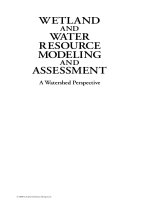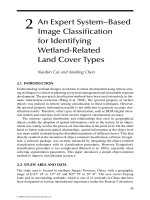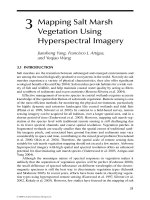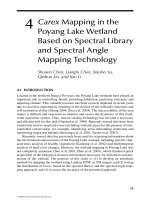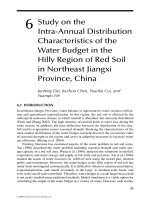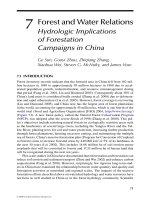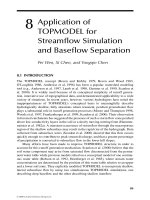WETLAND AND WATER RESOURCE MODELING AND ASSESSMENT: A Watershed Perspective - Chapter 11 pdf
Bạn đang xem bản rút gọn của tài liệu. Xem và tải ngay bản đầy đủ của tài liệu tại đây (496.49 KB, 12 trang )
129
11
Simulating Historical
Variations of Nitrogenous
and Phosphorous
Nutrients in Honghu
Lake Basin, China
Feng Gui, Ge Yu, and Geying Lai
11.1 INTRODUCTION
In recent years, eutrophication has become an increasingly serious environmental
problem in lake systems. Excessive nutrient enrichment is the root cause of eutro-
phication. Although lakes naturally receive nutrient inputs from their catchments
and the atmosphere, many human activities such as sewage inows, runoff from
agricultural elds, and industrial efuents have greatly accelerated the eutrophica-
tion process. To assess the relative roles of natural, climate-induced changes ver-
sus human-related activities, such as the removal of vegetation, it is important to
evaluate the natural trajectory of nutrient transportation over the catchments and its
contribution to a lake’s eutrophication. The eutrophication of the lakes in the most
developed region in China, the mid-lower reaches of the Yangtze River, has brought
great attention from the public, scholars, and government. As there are many types
of lakes in the Yangtze River basin, and the causes of eutrophication are different for
each type, Honghu Lake basin, which is located at the middle reach of the Yangtze
River, was chosen as the study area. Computational simulations with the SWAT (Soil
and Water Assessment Tool) model were used to reect the historical nutrient sedi-
mentation and transportation processes. With the application of the SWAT model,
the principle of nutrient transportation in the natural agricultural environment (the
environment under which the nutrient sedimentation and transportation processes
are only controlled by natural factors, such as topography, climate changes, and
natural vegetation cover, etc.) has been discussed in order to provide scientic basis
for the mechanism research of lake water eutrophication.
11.2 STUDY AREA
Honghu Lake, located at the middle reach of the Yangtze River (113°12’–113°26’E
and 29°40’–29°58’N) (Figure 11.1), is typical of a shallow water lake. As the larg-
est lake in Jianghan Plain, its geological setting is a faulted depression between the
© 2008 by Taylor & Francis Group, LLC
130 Wetland and Water Resource Modeling and Assessment
Yangtze River basin and the Dongjing River basin. The Honghu Lake region covers
both Honghu Lake County and Jianli County, an area of 344.4 km
2
.
1,2
Due to the lake
evolution and the impacts of human activities in recent centuries, Honghu Lake has
shrunk signicantly from its original coverage.
3,4
Honghu Lake basin, located at the northernmost area of China’s subtropical zone,
features a typical northern subtropical humid monsoon climate, with abundant diurnal
heating and precipitation in the same season. The average precipitation in the area is
approximately 1100 to 1300 mm, 77% of which is in the summer season. The average
annual runoff in this basin is approximately 37.35 × 10
8
m
3
.
1,5
The area receives water
from Chang Lake, San Lake, and White Dew Lake, with a watershed area of 8265 km
2
.
In the ood season, Honghu Lake receives water not only from the upstream area, but
also from overowing water from the downstream rivers. Prior to the 1960s, building
of the oodgate of Xin Tankou, located downstream of Neijing River, the oodwater
from the Yangtze River would overow through the Neijing River to Honghu Lake
(Figure 11.1). In the ood season, the basin area enlarges to 10,325 km
2
.
11.3 INTRODUCTION OF THE SWAT MODEL
SWAT (Soil and Water Assessment Tool) is a river basin–scale hydrological model
developed by the Agriculture Research Service of the U.S. Department of Agricul-
ture.
6–8
Its GIS-based version (AVSWAT 2000) has strong functionality in spatial
analysis and visualization. The SWAT model can be used to evaluate the impact of
land management practices on water, sediment, and agricultural-chemical yields in
large, complex basins with a variety of soils and land cover on a time scale of 10 to
E114.3
N30.1
E114.3
N29.4
E114.0
N29.4
Study area
River
N
Dongjing River
Kint and Kou
Hanjiank River
Yangtae River
Hang Lake
N
eij
ing
FIGURE 11.1 Location of study area.
© 2008 by Taylor & Francis Group, LLC
Simulating Historical Variations of Nitrogenous and Phosphorous Nutrients 131
100 years. There have been many successful applications of the SWAT model, with
longtime series outputs to reconstruct the past environment or to predict future envi-
ronmental changes.
9–11
11.4 BOUNDARY CONDITIONS AND SIMULATION DESIGN
11.4.1 B
OUNDARY CONDITIONS AND MODEL DATA PREPARATION
To simulate and evaluate the eutrophication of Honghu Lake basin under natural-
agricultural environments, the boundary conditions were set as natural-agricultural
time scenarios, including the following major factors: (1) natural topography, slope,
and channel, (2) climatic and hydrological factors (temperature, solar radiation, pre-
cipitation, and runoff), and (3) biomass of natural vegetation.
Based on these boundary values, the following data sets were compiled or cre-
ated for the model simulation: a database of land topography and hydrological units
were generated based on the 1:250,000 digital elevation models (DEM) published
by the National GIS Center of China.
12
A stream network data set was created by
digitizing 1:100,000 topography maps and using a “burn-in” method
6
by which a
stream network theme is superimposed onto the DEM to dene the location of the
stream network. This feature is useful in situations where the DEM does not provide
enough detail to allow the interface to accurately predict the location of the stream
network.
6
A 1:1,000,000 digital soil map with spatial and nonspatial information was
obtained from the Institute of Soil Science, Chinese Academy of Science (ISSCAS),
13
including information on sand, silt, organic material, soil pH value, total phospho-
rus, available phosphorus, and bulk density. Due to the difference in the soil texture
system between the SWAT standard (U.S. standard) and the standard of the second
national soil survey in China, the dataset used in this study was transformed into the
SWAT standard. Soil bulk density, available water capacity of the soil layer (SOL_
AWC), and saturated hydraulic conductivity (SOL_K) were calculated using SPAW
6.1.
14
The soil types were further classied into four different hydrological groups (A,
B, C, and D) according to the guidelines documented in the SWAT user manual.
8
Land use/vegetation data, obtained from a 1:1,000,000 China vegetation map,
15
were transformed to a grid le with a resolution of 10’x10’ to correspond to the plant
nutrient data. In this study, the vegetation data were used to provide land use infor-
mation. Within the study area, the major vegetation types are rice eld and wetland.
Thus, the corresponding land use types were classied into rice land, water, and
forested wetland, forested mixed.
Meteorological data were collected from weather stations located within or near
the basin, including daily precipitation, maximum and minimum temperature data
from 1951 to 2000, as well as daily radiation, average wind speed, and humidity
from 1980 to 2000. To generate meteorological data over the last 200 years, statisti-
cal values (such as standard deviation, skew coefcient of the daily precipitation and
temperature in a month, and the probability of a wet day after a dry day, etc.) reect-
ing the characteristics of the local climate were calculated by using the weather gen-
erator tool in the SWAT model.
All data mentioned above were transformed into the Arc/INFO grid format with
an Albers equal-area projection.
© 2008 by Taylor & Francis Group, LLC
132 Wetland and Water Resource Modeling and Assessment
11.4.2 SIMULATION PROCEDURE AND DESIGN
For the simulation experiment, we designed two scenarios according to the differ-
ence in watershed areas between the ood season (from June through August) and
the non-ood season (from March through May as well as from September through
February) (Figures 11.2 and 11.3).
We handle this source area change by adjusting the watershed outlet location as
well as the number. We selected one outlet location at the entrance of Honghu Lake
for the winter, while for summer we chose an outlet downstream of Honghu Lake.
Our procedure for simulation began with the construction of a background
and dynamic database of each subbasin, including geological sediment, topog-
raphy, climate, hydrology, soil, and vegetation coverage. We then subdivided the
watershed into several subbasins. Subbasins possess a geographic position in the
watershed and are spatially related to each other. We likewise subdivided the sub-
basins into HRU (hydrologic response units). HRUs are portions of a subbasin that
possess unique land use/management/soil attributes. To acquire the function of the
##
#
#
##
##
##
#
#
##
#
#
#
#
##
#
#
##
##
##
##
##
#
#
#
##
###
#
##
#
#
##
##
##
##
26
9
50
41
3
1
2
18
6
15
5
51
35
8
53
14
10
42
23
52
31
21
4
13
49
20
29
48
34
27
45
19
43
32
16
37
46
39
30
12
24
28
22
11
7
47
40
38 36
33
44
17
25
20 0 20 Kilometers
Watershed
Subbasins
Streams
Outlets
#
Linking stream added Outlet
Lake.shp
N
FIGURE 11.2 Watershed delineation and subbasin division for non-ood period.
© 2008 by Taylor & Francis Group, LLC
Simulating Historical Variations of Nitrogenous and Phosphorous Nutrients 133
nutrient source and transport dynamic of the land surface process, we evaluated all
of the databases to the subbasin and HRU levels. The next step involved running
the model with a time step of 24 hours and a continuous simulation of 200 years.
We then used sedimentary core records to compare and validate the simulation
output.
11.5 RESULTS AND DISCUSSION
11.5.1 S
IMULATION OUTPUT ANALYSIS
The source area change has little effect on the nutrient concentration, but has a larger
effect on the nutrient production and ow ux. There is an increase of approximately
25% in the ow ux and nutrient production in the summer season experiment.
11.5.1.1 Variability and Characteristics of Input Flow Flux
The results showed that the average yearly runoff ux was 46.1 × 108 m
3
. The runoff
distribution within a year has its peak value during the period from April through
September, in which the summer season (from June to August) contributes approxi-
mately one-half of the entire year’s runoff (Figure 11.4a).
##
#
#
##
##
##
##
##
##
##
##
##
##
##
#
##
##
##
##
##
#
#
##
##
##
##
##
##
#
#
##
##
##
##
##
26
35
9
38
60
51
3
1
39
2
18
6
15
42
5
61
45
31
8
63
14
10
52
23
62
36
21
4
13
59
20
32
58
44
27
55
19
53
37
43
16
47
56
49
33
12
29
24
28
22
11
40
30
7
57
34
50
48
46
41
54
17
25
Watershed
Subbasins
Streams
Outlets
#
Linking stream added Outlet
Lake.shp
20 0 20 Kilometers
N
FIGURE 11.3 Watershed delineation and subbasin division for ood period.
© 2008 by Taylor & Francis Group, LLC
134 Wetland and Water Resource Modeling and Assessment
11.5.1.2 Nutrient Changes in a Year
The annual means of TN (total nitrogen) and TP (total phosphorus) were plotted
in Figure 11.4. A negative correlation was observed between the ow ux and the
concentration of TN and TP, a lag between the peak value of ow and nutrient con-
centration. Due to the conuence of a channel in a large subbasin, only a portion of
the surface runoff will reach the main channel on the day it is generated, creating
a lag between the time the surface runoff was generated and the time it reaches the
main channel.
In the summer season when the rains are heaviest, the nutrient concentration
reached its lowest value because the nutrients were diluted by an abundant ow ux.
The highest annual nutrient concentration occurred in spring, perhaps due to cultiva-
tion activities during that period of time (Figures 11.4b, c).
1 2 3 4 5 6 7 8 9 10 11 12
0.02
0.04
0.06
0.08
0.10
0.12
0.14
0.16
0.18
0.20
Month
0.001
0.002
0.003
0.004
0.005
0.006
0.007
0.008
0.009
TP (mg/l)
TN (mg/l)
0
2
4
6
8
10
(a)
(b)
(c)
Flow (m
8
/a)
FIGURE 11.4 Simulation of annual mean of input ow ux, TN, TP.
© 2008 by Taylor & Francis Group, LLC
Simulating Historical Variations of Nitrogenous and Phosphorous Nutrients 135
11.5.1.3 Variations of Nutrient Concentration over Time
The nutrient concentration changes through time were analyzed seasonally. Both
TN and TP concentrations exhibited high variability. The maximum TP concentra-
tion appeared in the spring season and the minimum appeared in the summer, with
a relatively stable concentration in the time series. The maximum TN concentration
appeared in the spring and the minimum appeared in summer, with a slow increas-
ing trend in the time series (Figure 11.5).
11.5.1.4 Annual TP and TN Production
The annual average TN and TP production of the Honghu Lake basin was 420.25
tons per year and 19.613 tons per year, respectively. Analysis of the nutrient produc-
tion showed that the production of TN had a slow increasing trend with time, while
TP had no obvious trend. The nutrients in the Honghu Lake basin are characteristic
of an accumulated natural trend (Figure 11.6).
11.5.2 VALIDATIONS OF SIMULATION OUTPUTS
It is difcult to directly validate the 100-year simulations of nutrient production and
concentration due to the lack of long-term observation data. However, the simula-
tions can be indirectly validated by comparing the data with long-term sedimentary
nutrient records and establishing the statistical relations between them. In this study,
we focused on the study results from the 84-cm-long sedimentary cores HN (for
Honghu Lake North; collected at the northern part of Honghu Lake in November
2002 with a water depth of 3.2 m), and the relative
137
Cs-dating data, with the 150-
cm-long core H2-2002 (collected at the central part of Honghu Lake in 2002) as the
reference.
16,17
The analyses indicated that the sedimentation rate of Honghu Lake in
the last 540 years was about 0.155 cm/a. At 25 ~ 8 cm, the age approximately cor-
responds to the years 1840 to 1950.
16,17
Above 8 cm, the age corresponds to the year
1950. Chen Ping et al. (2004) determined the sedimentation rate of the core H2-2002
to be approximately 0.092 ~ 0.129 cm/a at layer D (above 22 cm in the core), sug-
gesting an age of approximately 150 years, from 1845 to 1992.
16
The dates of the two
cores are almost the same in each layer.
Because the simulation covers the time period between 1840 and 1950, a natural-
agricultural time, the simulated outputs could be validated by comparing the TN and
TP concentrations of relative layers with these age data of the cores as follows:
1. The nutrient concentrations in the core HN varied (Figure 11.7). Between
1840 and 1850, the TN concentrations increased while core depth decreased
and the concentration variability was 1.20 ~ 1.77 g/kg. Between 1959 and
2002, the nutrient concentration increased rapidly with the decrease of the
depth, and the variability was 1.77 ~ 8.78 g/kg. The TP concentration varied
through the core prole, with a peak value of 65 ~ 70 cm at the topmost 4
cm. The TP concentration also showed an increasing trend with the decrease
of depth, and reached 0.946 g/kg at the depth of 0.25 cm (Table 11.1).
© 2008 by Taylor & Francis Group, LLC
136 Wetland and Water Resource Modeling and Assessment
0.6
0.5
0.4
0.3
0.2
0.1
0.0
0.30
0.25
0.20
0.00
0.07
0.06
0.05
0.04
0.03
0.02
0.00
0.01
0.014
0.00
0.20
0.25
0.30
–0.02
0.00
0.02
0.04
0.06
0.08
0.10
0.12
0.14
0.16
0.18
0.20
0.012
0.010
0.008
0.006
0.004
0.002
0.000
0.000
0.005
0.010
0.015
0.020
200150100500 200150100500
200150100500 200150100500
0.025
0.020
0.015
0.010
0.005
0.000
200150100500
0.15
0.10
0.05
0.05
0.10
0.15
200150100500
200150100500 200150100500
TN concentration
10 years moving average
TP concentration
10 years moving average
SummerSpring
WinterFall
SummerSpring
WinterFall
Year
Year
mg/l
FIGURE 11.5 Change of nutrient concentration with time.
© 2008 by Taylor & Francis Group, LLC
Simulating Historical Variations of Nitrogenous and Phosphorous Nutrients 137
0 50 100 150 200
0 50 100 150 200
0
200
400
600
800
1000
TN annual production
10 years moving average
Year
0
10
20
30
40
50
60
70
TP annual production
10 years moving average
TP (t)TN (t)
FIGURE 11.6 Simulations of annual total phosphorus and total nitrogen production.
0
10
20
30
40
50
60
70
80
85
0 4 8
0.8 1.2 1.6
1840
FIGURE 11.7 Total nitogen and total phosphorus values in core HN (From Yao Shuchun,
Bin Xue, and Weilan Xia. Human impact recorded on the sediment of Honghu Lake. Journal
of Hohai University (Natural Sciences), 2004, 32 (Supplement): 154–159.
© 2008 by Taylor & Francis Group, LLC
TP (g/kg)TN (g/kg)
Depth (cm)
1950
138 Wetland and Water Resource Modeling and Assessment
2. The recent observations of water nutrients were obtained from the litera-
ture
3,4
and the measured data (the measured TN and TP concentrations of
the Honghu Lake water). Table 11.1 shows the water nutrient information.
We compared it with sedimentary records since the 1950s in order to exam-
ine the relations between the water nutrients and the sedimentary nutrients.
A regression was obtained as follows:
Y = 0.2475Ln(X) + 0.0864 (11.1)
where Y is the total nitrogen of the three types in water (mg/l) and X is the TN con-
centration in the sedimentary core (g/kg).
The correlation coefcient R
2
= 0.9557 was signicant for the sample size. With this
statistical relation, the sedimentary nutrient was used to calculate the water nutrient
in a time series, which was then applied to validate the results of simulated nutrients
in the lake water.
As shown in Table 11.2, during the period of 1840 to 1950, the variability of
nitrogen in water was 0.13 ~ 0.23 mg/l, with an average value of 0.19 mg/l. The
simulated nitrogen concentration for the same period was 0.071 ~ 0.11 mg/l, with an
average value of 0.09 mg/l.
According to Table 11.2, the difference between the simulations and referenced
calculations is approximately 50%. This difference may have occurred because there
are two sources of lake nutrients, the internal (lake) source and the external source,
while the simulation only took into account the nitrogen from the external sources. As
such, the simulation output represents the level of the nutrients transported from the
entire basin into the lake water and does not account for the nutrients produced from
the lake water itself. As many studies
18,19
have suggested that the internally sourced
nutrients play an important role in lake eutrophication, these nutrients should be con-
sidered in order to fully understand nutrient level changes in lake water. While the
contribution of internally sourced nutrient release in Honghu Lake cannot presently
TABLE 11.1
The water nitrogen concentrations
statistically calculated based on the
sedimentary nitrogen values.
Core TN
(g/kg)
Calculated nitrogen
in water
(mg/l)
1960s 2 0.28
1970s 3 0.32
1980s 3.8 0.41
1990s 5.8 0.558
2002 8.3 0.597
© 2008 by Taylor & Francis Group, LLC
Simulating Historical Variations of Nitrogenous and Phosphorous Nutrients 139
be estimated, it should not be neglected, and considering this effect, our simulation
results could be better compared.
11.6 CONCLUSIONS
The simulations using the SWAT model helped explain the nutrient changes in the
Honghu Lake basin. Both the nutrient concentrations in sediment records and the
water body showed an increasing trend since the 1950s. The nutrients have slowly
accumulated in the basin; the increase in the past 50 years appeared more signicant
than the 50 years prior to that.
The study indicated that the SWAT model could be an effective tool for evaluat-
ing the nutrient production and changes in a lake watershed on a time scale of several
hundreds of years. Thus, the model simulation may help understand some effects of
long-term climate changes under human impacts.
ACKNOWLEDGMENTS
This study was funded by the National Key Fundamental Research and Development
Planning Program (Grant No. 2002CB412300-1) and by the Innovation Program of
Nanjing Institute of Geography and Limnology, Chinese Academy of Sciences (Grant
No. KZCX1-SW-12) and all measured data were provided by Yang Xiangdong.
REFERENCES
1. Wang, Suming, and Hongshen Dou, eds. 1998. China Lake. Beijing: Science Press,
580.
2. Compile committee of water conservancy. 2000.
Hubei Water Conservancy Records
Beijing: China Water Conservancy and Water Electricity Press.
3. Chen, Shijian. 2001. Environmental problems and ecological countermeasures for
Honghu Lake in Hubei province. Journal of Central China Normal University (Natural
Sciences) 35(1):107–110.
4. Wang, Fei, and Qiming Xie. 1990. The succession trend and management countermea
-
sure for Hong wetland ecosystem. Rural Eco-environment 2:21–25.
5. Xiang Guorong, ed. 1997.
Research on sustainable development of wetland agriculture
in Sihu region. Beijing: Science Press, 271.
TABLE 11.2
Comparisons of simulated nitrogen
concentrations with calculated values.
Simulated TN
(mg/l)
Calculated
nitrogen values
(mg/l) Accuracy
Maximum 0.114 0.228 0.502
Average 0.090 0.195 0.463
Minimum 0.076 0.132 0.581
© 2008 by Taylor & Francis Group, LLC
140 Wetland and Water Resource Modeling and Assessment
6. Di Luzio, M., R. Srinivasan, J. G. Arnold, et al. 2002.
Arcview interface for SWAT2000
user’s guide. College Station: Texas Water Resources Institute TR-193, 345.
7. Neitsch, S. L., J. G. Arnold, J. R. Kiniry, et al. 2002.
Soil and Water Assessment Tool
theoretical documentation, version 2000. College Station: Texas Water Resources
Institute TR-193, 498.
8. Neitsch, S. L., J. G. Arnold, J. R. Kiniry, et al. 2002.
Soil and Water Assessment Tool
user’s manual, version 2000. College Station: Texas Water Resources Institute TR-193,
438.
9. Hu, Yuanan, Shengtong Cheng, and Haifeng Jia. 2003. Hydrologic simulation in NPS
models: Case of application of SWAT in Luxi watershed. Research of Environment
Science 16(5):29–32.
10. Jayakrishnan, J., et al. 2005. Advances in the application of the SWAT model for water
resources management. Hydrological Processes 19:749–762.
11. Borah, D. K., and M. Bera. Watershed-scale hydrologic and nonpoint-source pollu
-
tion models: Review of applications. American Society of Agricultural Engineers
47(3):789–803.
12. National GIS Center of China. 1999. Database of 1:2500,000 topography of China.
Beijing: National GIS Center of China.
13. Shi, X. Z., D. S. Yu, E. D. Warner, et al. 2004. Soil database of 1:1,000,000 digital soil
survey and reference system of the Chinese Genetic Soil Classication System. Soil
Survey Horizon 45(4):129–136.
14. Saxton, K.
Soil—Plant—Atmosphere—Water (SPAW) eld and pond hydrology opera-
tional manual (version 6.02). Washington, DC: U.S. Department of Agriculture, Agri-
cultural Research Service, 23.
15. Hou, Xueyu. 1988.
China physical geography (botanical geography). Beijing: Science
Press, 318.
16. Chen, Ping, Baoyan He, Eudo Kunihiko, et al. 2004. Records of human activities in
sediments from Honghu Lake. Journal of Lake Sciences 16(3):233–237.
17. Yao, Shuchun, Bin Xue, and Weilan Xia. 2004. Human impact recorded on the
sediment of Honghu Lake. Journal of Hohai University (Natural Sciences) 32
(Supplement):154–159.
18. Wetzel, R. G. 2001.
Limnology—lake and river ecosystem. London: Academic Press.
19. Qin, Boqiang, and Chengxin Fan. 2002. Exploration of conceptual model of nutri
-
ent release from inner source in large shallow lakes. China Environment Science
22(2):150–153.
© 2008 by Taylor & Francis Group, LLC

